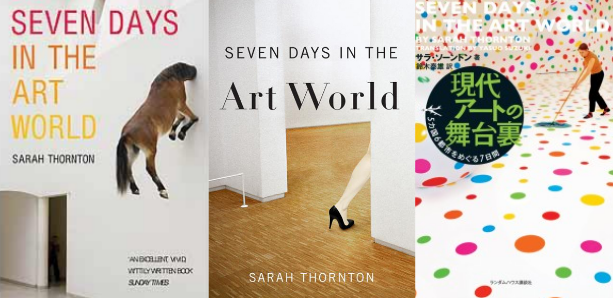

“It’s like having your own spy in the art world. Thornton parachutes the reader into the fascinating nitty-gritty of how it all works.” – Alan Yentob, BBC
“The best book yet, about the modern art boom…” – Sunday Times
“Thornton captures the essence, appeal, complexity, and the mass of contradiction that permeates the rarefied art world and often fascinates outsiders.” – Reuters
Who has not gnashed their teeth in anger at some of what passes for art in recent years? Who has not convulsed with despair at the obscene amount of money spent by collectors? Who has not tried desperately to decipher that blurry line where art ends and junk begins? Who has not contemplated with secret glee the prospect of seeing metaphoric egg on the literal faces of one bombastic art critic or another? – Many a jeremiad has been spouted by outraged punters visiting modern art galleries; and many a diatribe railed against the pompous and highfalutin world of contemporary art.
Finally we have a less fly-on-the-wall and more soldier-in-the-trenches account of how art has become mass entertainment, a luxury good, a job description and a kind of alternative religion. Sarah Thornton’s vastly entertaining book, with its fast pace and gossipy tone, takes the reader inside this bizarre world of critics and collectors—a world that is closed shut to riff-raff, hoi-polloi, middle-class nobodies like the rest of us.
Thornton gets cracking by breaking things down immediately for the uninformed reader by pointing out the six distinct roles one comes across in the art world: artist, dealer, curator, critic, collector, or auction-house expert. Over the course of the book, Thornton introduces the reader to any number of high society characters ridden with status anxiety desperately concerned about “hierarchies of fame, credibility, imagined historical importance, institutional affiliation, education, perceived intelligence, and wealth.” She astutely observes that for many art insiders, art—especially conceptual art—is a substitute religion—an avenue down which to direct their existential impulses. In her own charming words, conceptual art, “demands leaps of faith, but it rewards the believer with a sense of consequence.”
Thornton is nothing if not incredibly forthright in her observations and psychological insights. She is delightfully perspicacious with a remarkable sense of humour and economical turn of phrase that manages to capture the rub of things precisely. Consider the pith and metaphor of this passage for instance, “Artists make work that ‘look like art’ and behave in ways that enhance stereotypes. Curators pander to the expectations of their peers and their museum boards. Collectors run in herds to buy work by a handful of fashionable painters. Critics stick their finger in the air to see which way the wind is blowing so as to ‘get it right’.”
However, it must be hastily pointed out that Thornton’s tone throughout the book is not one of sneering derision, but rather one of a curious outsider reporting on the strange goings-on inside this lofty world of contemporary art.
Thornton offers a thought-provoking analysis of why art has become so popular: The more educated we’ve become the stronger our appetite for rare, complex, one-of-a-kind cultural goods. It helps dissociate oneself from mass-produced, machine-created merchandise. Also, as so many aspects of popular culture become dumbed down and are made accessible to the lowest common denominator, there has been a concomitant rise in interest among certain sections of the audience to this domain of art that requires active effort and intellectual rigour to enjoy. Thornton opines that an increased visual literacy (universal access to television and YouTube) has led to an increased interest in passive visual stimulation among the populace. And finally, another reason for the resurgent interest in art in recent times is that art has become the lingua franca among the rich and famous. It is a way for them to create an in-group against the bourgeois herd.
In the words of Amy Capellazzo of Christie’s auction house, “After you have your fourth home and a G5 jet, what else is there? Art is extremely enriching. In a digital world of cloneable cultural goods, unique art objects are compared to real estate.”
The rest of the book is divided into seven easy-to-read chapters about the sub-culture of art and what art means to different sections of the art world. In ‘The Auction’ art is an investment and luxury good. In ‘The Crit’ art is an intellectual endeavour, lifestyle and occupation. In ‘The Fair,’ art is a fetish and lesure activity. In ‘The Prize,’ art is a museum attraction, a media story. In ‘The Magazine,’ art is an excuse for words—something to debate or promote. In ‘The Studio Visit,’ it’s all of the above. And finally, in ‘The Biennale’ art is an excuse for networking—an international curiosity.
All in all, this well-researched, insightful book takes the reader on a whirlwind journey with encounters along the way with museum directors, famous art collectors, art house auctioneers, Turner Prize winners, and intense art students. It will definitely satisfy the curiosity of the layperson who has wondered about the tribal world of the vulgarly rich and their fetish for highly priced works of creativity that some call art and others call nonsense.